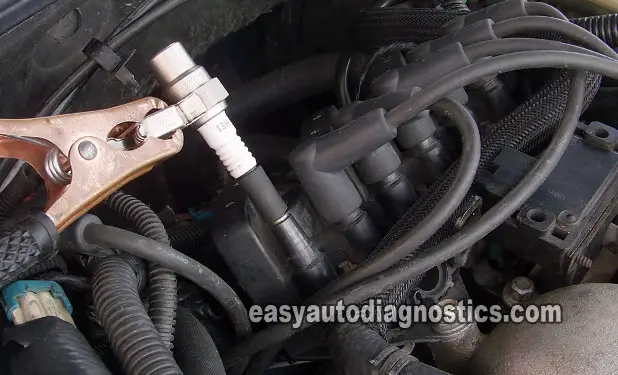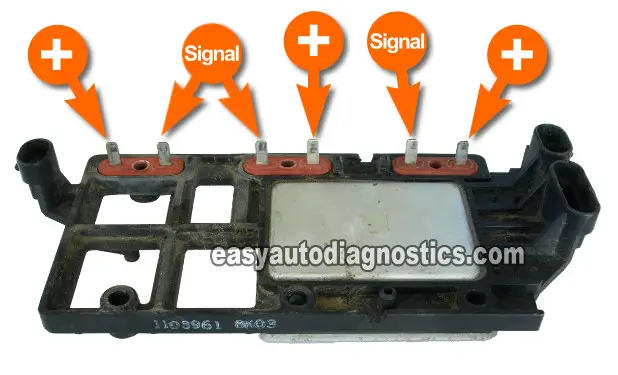TEST 3: Testing Spark At Two Adjacent Towers Of Same Coil

You've reached this test section because two spark plug wires, that connect to the same ignition coil, did not fire off spark in TEST 1.
What we're going to do is check for spark directly on these two ignition coil towers with the spark tester. We'll check each tower one at a time.
These are the test steps:
- 1
Remove the spark plug wire from one of the two ignition coil towers.
NOTE: Remember, you're testing for spark on the ignition coil whose two spark plug wires did not spark in TEST 1. - 2
Attach the HEI spark tester with a piece of vacuum hose to this tower.
- 3
Connect the HEI spark tester to the battery negative (-) post with a battery jump start cable.
- 4
Have your helper crank the car while you observe the HEI spark tester.
- 5
You're gonna' get one of two results:
1.) Spark
2.) No spark. - 6
Remove the spark tester from the tower and reconnect the spark plug wire to it.
- 7
Repeat steps 1 thru' 5 on the other ignition coil tower (of the same ignition coil).
Let's take a look at what your test results mean:
CASE 1: You got spark from both towers (of the same ignition coil). This results confirms that the spark plug cables, that connect to the ignition coil, are bad. Replacing the spark plug cables will solve the problem.
CASE 2: You got NO spark from both towers (of the same ignition coil). The next step is to make sure that that ignition coil is getting power. For this test go to: TEST 4: Verifying That The Ignition Coil Is Receiving 12 Volts.
CASE 3: One tower sparked but the other did not. This test result tells you this specific ignition coil is bad and needs to be replaced.
Here is why: The ignition coil is designed to simultaneously spark from both towers. Since your test result confirmed that only one of the two towers is sparking, then you can correctly conclude that the ignition coil is bad.
TEST 4: Verifying That The Ignition Coil Is Receiving 12 Volts

You've reached this test step because the results of your tests confirm that there's no spark coming out of two adjacent towers of the same ignition coil. The next step is to verify that the ignition coil is receiving 12 Volts. Depending on the results you'll obtain, you'll be able to say that the ignition coil or the ignition control module (ICM) is bad or continue to the next test step.
You'll have to remove the ignition coil, that is not firing spark from both its towers, to expose the two male spade terminals that feed it power and the Switching signal (as shown in the photo above).
IMPORTANT: Now, this is an on-car test, do not remove the ignition control module or all of the ignition coils from the vehicle. Also, do not disconnect the ICM from its electrical connectors. The photos in this part of the article show the whole assembly off of the car just to make it easier to explain the test.
These are the test steps:
- 1
Remove the ignition coil from the ignition control module assembly. Remember, this is the ignition coil whose 2 towers did not fire off spark in TEST 3.
- 2
Set your multimeter to Volts DC.
- 3
Connect the black multimeter test lead to the battery negative (-) terminal.
- 4
Probe the male spade terminal labeled with the + symbol with the red multimeter test lead (see photo above).
- 5
Have your helper turn the key ON with the engine OFF.
- 6
Your multimeter should register 10 to 12 Volts.
Let's take a look at what your test results mean:
CASE 1: The multimeter registered 10 to 12 Volts (or the test light came ON). This is a clear indication that the ignition coil is receiving power.
Now the next step (and the last one) is to test for the Switching signal. Go to: TEST 5: Verifying The Ignition Coil's Switching Signal.
CASE 2: The multimeter DID NOT register 10 to 12 Volts (or the test light DID NOT come ON). This test result confirms that the ignition control module is fried. Replace the ignition control module. Why?
Here's why: All of the ignition coils get power from the same circuit (or fuse/relay) that feeds the ignition control module. The module, once it receives this voltage feed, supplies all three coils with power. Since you verified that all of the other ignition coils are sparking, you have indirectly confirmed that they're receiving voltage also. Therefore, if one coil of the three isn't getting power, its the ignition module's fault.
